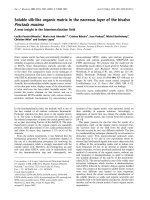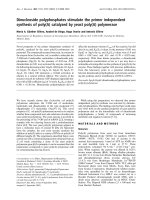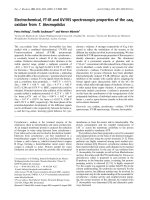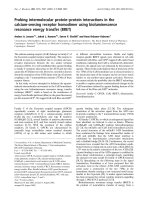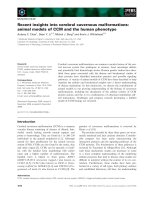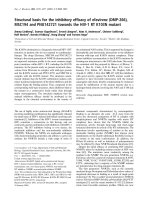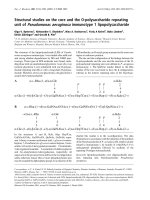Báo cáo y học: "Colony variability under the spotlight in animal models of arthritis" pps
Bạn đang xem bản rút gọn của tài liệu. Xem và tải ngay bản đầy đủ của tài liệu tại đây (41.11 KB, 2 trang )
Available online />Page 1 of 2
(page number not for citation purposes)
Abstract
A recent article by Farkas and colleagues, published in Arthritis
Research & Therapy, is from the laboratory of Dr Tibor Glant and
his research team in Chicago, who have investigated in
considerable depth the immunopathology of experimental arthritis
induced by the major cartilage component proteoglycan aggrecan
in an animal model that mimics many features of human rheumatoid
arthritis and ankylosing spondylitis. This present report takes our
understanding a significant step forward by questioning whether
genetic drift in distinct colonies of the same inbred strains of mice
has an impact on the parity between data published by different
laboratories.
In the previous issue of Arthritis Research & Therapy, Farkas
and colleagues [1] compare a large number of colonies of the
widely used BALB/c inbred mouse strain; the authors com-
municate largely good news that substrains vary only modestly
in phenotype and the incidence and severity of arthritis.
Confidence in data derived from studying the mechanisms of
immunopathology in patients with rheumatoid arthritis (RA) or
ankylosing spondylitis is undermined by many variables. One
is the genetic diversity of patients in a single cohort or
diversity between cohorts studied in different laboratories.
Despite a strong association between the expression of
certain HLA DR alleles and RA, many additional major
histocompatibility (MHC) and non-MHC loci that will differ
between individuals are thought to contribute to RA
pathogenesis [2]. As a consequence, RA cohorts in studies
to date have included patients with a spectrum of disease; it
is unlikely, therefore, that a single aetiology will account for
disease in all these patients and future studies are likely to
segregate patients into distinct disease subsets [3].
The major alternative approach to understanding the
pathogenesis of RA avoids these variables by studying the
mechanisms of disease in genetically defined animal models.
A variety of models of autoimmunity have been developed,
each providing a window on some, but not all, aspects of the
immunopathology [4]. Of course, animal models have their
own drawbacks, such as whether the immune system of the
mouse parallels that in human, and how similar the disease
processes observed in experimental arthritis are to RA [5].
Received wisdom therefore asserts that a synthesis of the
information gleaned from several different animal models,
combined with studies possible in RA patients, is likely to
lead us forwards in the search for better rational therapies.
In particular, the reductionist approach has been taken by
exploiting the genetic homogeneity of inbred mice in which
autoimmune arthritis can be induced by synchronised
immunisation of groups of animals with single candidate joint
autoantigens in adjuvants. The reliable kinetics of the
consequent immune response can then be studied in relation
to the ensuing RA-like disease pathology. This approach
offers the opportunity to observe the sequence of events
during disease onset and provides clear answers to
questions such as the composition of cellular infiltrates into
the synovium and the mechanisms of cartilage and bone
destruction.
The most widely studied animal models are collagen-induced
arthritis [6] and proteoglycan-induced arthritis (PGIA) [7] in
which inflammatory arthritis is induced by immunising
genetically susceptible strains of inbred mice, sometimes
transgenic for disease-associated HLA alleles or T cell
antigen receptors specific for arthritogenic peptides from
joint autoantigens. The best studied autoantigens are the two
major cartilage components, type II collagen and
proteoglycan aggrecan, both joint autoantigens that induce
RA-like disease in mice as well as recall T cell response in a
proportion of RA patients [8,9].
In this context, the article by Farkas and colleagues [1]
explores the difference in PGIA in multiple colonies of the
Editorial
Colony variability under the spotlight in animal models of arthritis
John H Robinson
Musculoskeletal Research Group, Institute of Cellular Medicine, Newcastle University, Framlington Place, Newcastle upon Tyne NE2 4HH, UK
Corresponding author: John H Robinson,
Published: 30 April 2009 Arthritis Research & Therapy 2009, 11:110 (doi:10.1186/ar2653)
This article is online at />© 2009 BioMed Central Ltd
See related research article by Farkas et al., />MHC = major histocompatibility complex; PGIA = proteoglycan-induced arthritis; RA = rheumatoid arthritis.
Arthritis Research & Therapy Vol 11 No 2 Robinson
Page 2 of 2
(page number not for citation purposes)
same inbred strain of mouse, the universally studied BALB/c,
which is the most susceptible to PGIA. The goal of the
research was to compare the incidence and severity of PGIA
and proteoglycan-induced spondylitis and to determine
expression patterns of a panel of relevant genes in a large
number of distinct colonies of the susceptible mouse strain
BALB/c. Although induction of disease by the usual
immunisation regime did not reveal any differences in
incidence and severity, the sub-lines of BALB/c mice showed
modest but significant differences in immune parameters
such as cytokine and antibody responses and clinical scores
when disease was induced with suboptimal doses of
aggrecan, clearly revealing genetic drift in the colonies that
affects the immune response and disease pathology.
In conclusion, the present report strengthens the validity of
previous studies of the PGIA model in different laboratories,
and throws down the gauntlet as a challenge to research
groups that use inbred strains of mice as models for other
human diseases, particularly in cases when groups have
published contradictory data.
Competing interests
The author declares that they have no competing interests.
References
1. Farkas B, Boldizsar F, Tarjanyi O, Laszlo A, Lin SM, Hutas G,
Tryniszewska B, Mangold A, Nagyeri G, Rosenzweig HL, Finnegan
A, Mikecz K, Glant TT: BALB/c mice genetically susceptible to
proteoglycan-induced arthritis and spondylitis show colony-
dependent differences in disease penetrance. Arthritis Res
Ther 2009, 11:R21.
2. Oliver JE, Worthington J, Silman AJ: Genetic epidemiology of
rheumatoid arthritis. Curr Opin Rheumatol 2006, 18:141-146.
3. van der Helm-van Mil AH, Huizinga TW: Advances in the genet-
ics of rheumatoid arthritis point to subclassification into dis-
tinct disease subsets. Arthritis Res Ther 2008, 10:205.
4. Holmdahl R: Dissection of the genetic complexity of arthritis
using animal models. Immunol Lett 2005, 103:86-91.
5. Rosenthal N, Brown S: The mouse ascending: perspectives for
human-disease models. Nat Cell Biol 2007, 9:993-999.
6. Brand DD, Kang AH, Rosloniec EF: Immunopathogenesis of
collagen arthritis. Springer Semin Immunopathol 2003, 25:3-18.
7. Glant TT, Finnegan A and Mikecz K: Proteoglycan aggrecan-
induced arthritis: Immune regulation, cellular mechanisms
and genetics. Crit Rev Immunol 2003, 23:199-250.
8. Kim HY, Kim WU, Cho ML, Lee SK, Youn J, Kim SI, Yoo WH, Park
JH, Min JK, Lee SH, Park SH, Cho CS: Enhanced T cell prolid-
ferative response to type II collagen and synthetic peptide CII
(255-274) in patients with rheumatoid arthritis. Arhtritis Rheum
1999, 42:2085-2093.
9. Zou J, Zhang Y, Thiel A, Rudwaleit M, Shi S-L, Radbruch A, Poole
R, Braun J, Sieper J: Predominnant cellular immune response
to the cartilage autoantigenic G1 aggrecan in ankylosing
spondylitis and rheumatoid arthritis. Rheumatology 2003, 42:
846-855.

